Osteochondrosis is the most common cause of back pain.The damage to the intervertebral discs underlying the development of the disease is in each second person who has reached 40 years of age, and at the age of 50, 70% of the population is already surprising.At the same time, today osteochondrosis is increasingly found in young people and even teenagers.Intervertebral hernia, radicolite, brain supply disorders: all these are complications of osteochondrosis that threaten disability and often lead to disability.
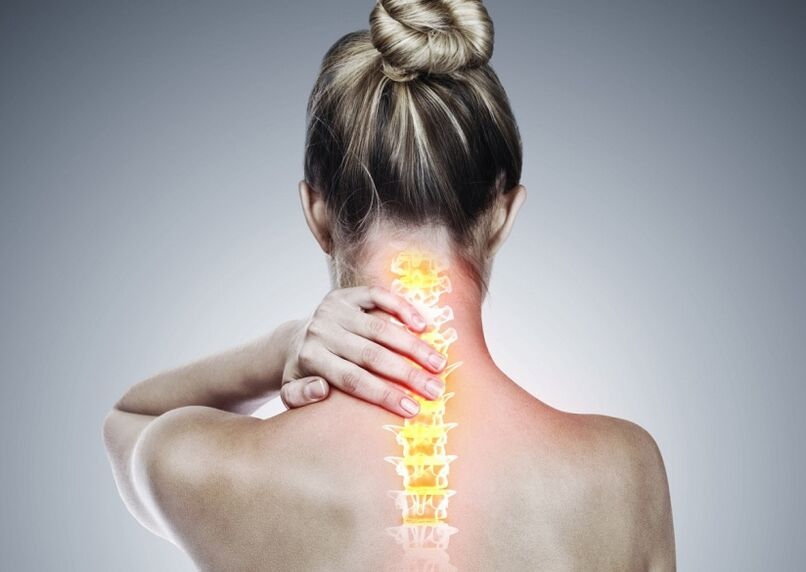
Currently, effective treatment methods that not only eliminate symptoms, but also help restore the destroyed areas of vertebrae, in traditional medicine, almost.Therefore, it is very important to understand what factors lead to the destruction of discs, what should be changed in their lifestyle to stop the development of osteochondrosis.And what measures should be taken to face existing changes and launch recovery processes in the spine.
What is osteochondrosis?How is the disease progress?
Osteochondrosis is a disease in which the processes of destruction in the spinal segment -motor begin to prevail over the recovery processes, which is manifested by back pain, a limitation of mobility, etc.In the course of the development of this disease, intervertebral hernia, radiculitis (radical piculopathy), Ishias and other complications can form.
The intervertebral disk (hereinafter, called "disc") is an elastic fabric ring, whose fibers are woven in a mild and underlying vertebra.Due to its special structure, the intervertebral disc protects each vertebra from destruction, and also guarantees the mobility of the entire column (trends, torsion).
In the center of the intervertebral disc there is a pulpal nucleus, which resembles a rubber pillow full of liquid.In an adult, it consists of 70% water, as well as carbohydrates that can join and give water.At the time of load in the corresponding segment of the spine, the core gives water and bananas, and after the termination of the effect it takes the previous shape.Such shock absorbent pillow allows the column to extend and extinguish up to 80% of the shock load that reaches the column.
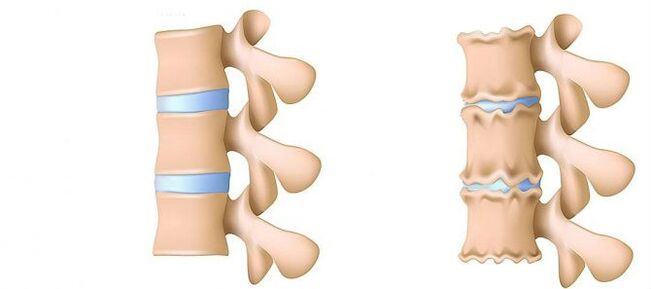
Degenerative discrete processes often begin with a deterioration in the intervertebral disc absorption function.
- Deterioration of the blood supply to the intervertebral disc.In adults, the food of the intervertebral discs is carried out by diffusion: the blood is administered only to the vertebrae, and already through them "filters" the discs.In the best way, the disc is fed during dynamic loads (for example, walking), since the principle of the pump (output of the processed fluid when compressed, the flow of nutrients and oxygen by eliminating the load).Therefore, the nutrition of intervertebral discs is difficult, especially in the conditions of a sedentary lifestyle (hypodinamia).
- Changes in the nucleus of the Pulpic disc.With a deterioration in the blood supply, the water supply, sugars and amino acids to the octopus nucleus is altered.Because of this, the production of carbohydrates that connect water suffers.The nucleus is dehydrated, its structure made of gel becomes fibrous, the ability to sprout and extinguish the shots worsen.This increases the load in the fibrous ring and the vertebrae, they are more likely to be blocked and injured.
- Changes in the fibrous ring of the intervertebral disc.Due to the flattening of the octopoose nucleus, the increase in the load is found in the fibrous disk ring.In conditions of poor blood supply, the fibrous ring loses its resistance.The instability of the column occurs, which can lead to the formation of an intervertebral hernia, a displacement of the vertebrae and the damage to the spinal cord or the nerve roots.
- Disc protuberance.The formation of intervertebral hernia.As the fibrous ring fibers weaken, the pulpic nucleus begins to excel, for example, towards the intervertebral channel (disc protuberance).Such amazing can lead to a rupture of a fibrous ring and the formation of a hernia.Read more about the intervertebral hernia formation process in a separate article: "Effective treatment of intervertebral hernia in the home".
- Spondyosis: the destruction of intervertebral joints (spondilatrosis), the growth of osteophytes and ligament ossification.Parallel to the formation of intervertebral hernia in the osteochondrosis, damage to the intervertebral joints are observed, destructive changes in the vertebra (cartilage) and ligaments are observed.
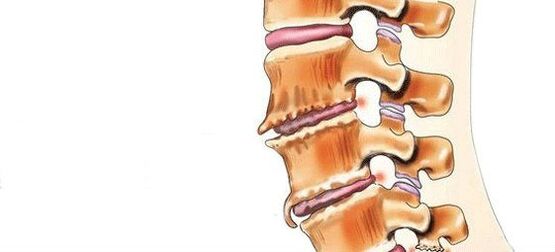
Since the shock absorption function of the intervertebral disc, the vertebrae and the small intervertebral joints are not performed, they begin to constantly injure.
The instability of the spine is also the cause of the cartilage damage of the bodies of the vertebrae and the joint processes.As a result, bone tissue grows, osteophytes appear(Greek: Osteo - Bone, Fito - Plant)- Bone growth.The appearance of osteophytes is popularly called the formation of peaks or the deposition of salts.
- Osteophytes can constantly irritate the ligaments of the vertebral segment, which gradually leads to their ossification and limiting movements in the affected spine.
- Osteophytes can also damage nearby soft tissues, whose result is the accumulation of dead cells in them, to which the body reacts with inflammation (edema).
- Osteophytes on the surfaces of the vertebrae that look at the intervertebral discs damage the fibrous ring fibers, accelerating the formation of a hernia.The osteophyte, which grows towards the intervertebral channel, improves the compression of the spinal cord, blood vessels, nerve roots.
- The growth of osteophytes can lead to the wrapping of neighboring rooms and the complete loss of mobility in the vertebral segment.
Symptoms and signs
Symptoms and signs of osteochondrosis: back pain!Initially, back pain can occur due to the excess of the back of the back muscles that try to center the vertebrae excessively (stage 3), so the muscles protect the spinal cord located in the spine.The spinal cord is the central part of the nervous system, so the body tries to avoid its damage (squeezing, irritation).Subsequently, the cause of pain can already be the vertebrae of the vertebrae, hernial protrusion even with a small size.At the time of the appearance of a hernia, a person, as a rule, feels severe pain (this is what is called friendly or lumbar).

Due to back pain, an involuntarily seeks to take a position in which the intensity of pain, forced poses, calls and calls decreases.At the same time, the column is in a non -violent position that reduces the depreciation capacities of the discs.This increases the risk of its greater damage.
As violations progress in the joints, the development of the ossification of vertebral bodies, joint surfaces and ligaments, the patient's column begins to lose mobility.Partial, and then complete restrictions on movements in the affected spine.
Complications of the spine osteochondrosis
There are several stages of development of complications of the spine osteochondrosis.Its manifestations depend on the department in which the destructive process occurs.
- Radiculita Discogenic (Radiculopathy), in which the hernial protuberance squeezes the nerve root (a lot of nerve fibers, which extends from the spinal cord and subsequently divided into nerves going to one or another area of the body).The pain is due to both the mechanical effect of hernia in the spine and the addition of inflammation (edema).
- Vascular brown syndrome, in which the vessels that feed the roots of the spinal cord are squeezed.It is manifested by deteriorated movements in the hands (with cervical osteochondrosis) or lower limbs (with lumbosacro), as well as a loss of sensitivity.With this complication, the work of the internal organs can suffer, to which the affected nerves are (urine, sexual function, intestinal work, etc.), can develop, hypertension develops and the deterioration of memory occurs.Sometimes, vascular infraction occurs suddenly, with an acute movement in the affected area of the column, more often, in the lower back.There is acute pain and sudden weakening of the muscles on the affected side: syndrome "Paralytic Isshias"
- Blood supply violation to the spinal cordcaused by the compression of vessels that feed the spinal cord.The extreme degree of complication is a ischemic spinal stroke.The result of this complication is the deteriorated movements in the extremities (paresis, paralysis), loss of sensitivity, deterioration in the work of the internal organs to complete the rejection.In some cases, this can lead to the patient's death, for example, when renal function suffers seriously.
The symptoms of discogenic radiculitis depend on the spine:
| Location | Symptoms and signs |
|---|---|
| Cervical Radiculita, Cervical-Torma | Depending on the level of damage, pain and deteriorated sensitivity on the neck, the shoulder, the forearm, the fingers occur.You can also see muscle weakness in these departments. It often joins the neuralgia of the occipital nerves, in which severe pain is observed in the back of the head.Arrhythmia can occur. |
| Lumbar-Cross Radiculita | It is manifested by the pain in the lower back, which is often combined with pain during the sciatic nerve: Ishias, Ishiradiculita.The weakness of the foot muscles also develops, a violation of sensitivity in the thigh, the lower part of the legs and feet can occur. |
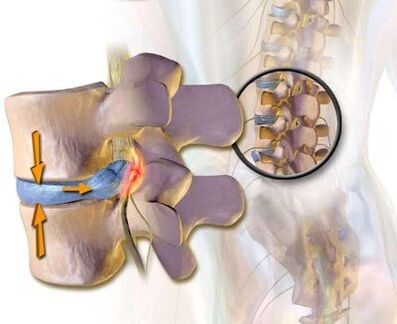
The displacement of vertebral bodies or intervertebral discs with the subsequent squeeze of blood vessels and nerve roots may require urgent surgical intervention.
The reasons for the development of the spine osteochondrosis
Osteochondrosis is called multifactorial disease, that is, there may be many reasons for its occurrence.Here we will highlight two key factors that gradually lead to the defeat of intervertebral discs and subsequent changes in the spine:
- Deterioration in the conditions of the food source of the intervertebral discs, as well as the cleaning of their tissues.
- Excessive load in the column, which leads to the accumulation of dead cells in the backbone of the vertebral segment.
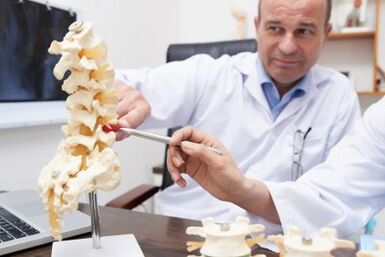
The update of the intervertebral discs tissues depends on the sufficiency of the blood flow and the lymphatic flow directly to the intervertebral discs, neither the blood nor the lymphatic vessels are adequate (which serve in the body to the clean tissues).The food and the cleaning of the disc are carried out indirectly, that is, slowly.This is the reason why in this area not only happens quicklyNutrient deficiency and oxygen hungerBut also quicklyDamaged and dead cells accumulateas well as elaborate substances.The cleaning of "slag" fabrics is necessary, otherwise there will be no place for the occurrence of new functional cells, and then the fabric will gradually lose its function (for example, the nucleus of octopoos of the disk will stop sprouting, depreciation and will flatten slow).
The update of intervertebral discs tissues depends on the sufficiency of blood flow and lymphatic flow.The speed and strength of these processes are influenced by the muscle microvibration created (mainly) backup muscles during physical stress.In this sense, one of the reasons for the food and cleaning deficiency is hypodinamia when the back muscles are relaxed or in a static position.
As the osteochondrosis, the supply of blood, lymph and venous exit in the column develop, can deteriorate due toMuscle spasm.The body gives a signal to the muscles to keep the vertebrae in a certain position with each other in the affected area.For a long time, the outstanding muscles press the vessels for a long time, which exacerbates the situation even more.
It is obvious to most people that the column can suffer in the case of an unusual weightlifting or when the lesions, however, the damage to the column can be daily and not so tangible in case of violation of the neuromuscular depreciation system.Constant microtraumas in weak lymphatic flow conditions lead to the accumulation of dead cells, prevent the growth of functional cells and lead even more to the ossification of tissues.
Violation of neuromuscular depreciation as one of the main causes of osteochondrosis
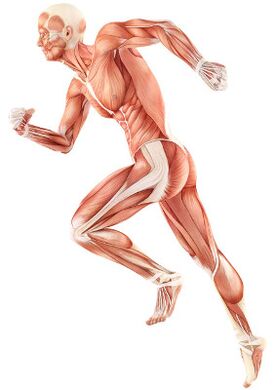
Violation of neuromuscular depreciation as one of the main causes of osteochondrosis to reduce the load in the column when walking, lifting weights, etc.The body has a complete neuromuscular depreciation system.It is ensured by the functioning of the body's nervous system and skeletal muscles that interact in accordance with guaranteeing soft movements and extinguishing shock loads in the bones, joints and, of course, the backbone.Then, most shock loads must extinguish foot.In addition, leg muscles and back are involved in depreciation.If this does not happen (for example, high -heeled uncomfortable shoes do not allow the foot to work), intervertebral discs are subject to clashes for those who are not destined.The factors that lead to discord in the neuromuscular depreciation system are listed below:
- Posture violation- Several types of spinal curvatures that prevent "outbreaks", the use of non -physiological furniture when working in the office, etc.
- Violation of the march, execution techniques (correctly when executed, transfer foot from the foot to heel);
- Wear or without heels, which negatively affects foot depreciation capabilities.
- Excessive loads(practice sports, exhausting physical work), traumatic joints and spine
- Obesity- Excess weight changes the center of gravity of the body, as well as the adipose tissue complicates the blood supply to the muscles, the behavior of the nerve impulses;
- Driving in transport sitting without depreciation (in a standing position can sprout with your feet);
- Nervous system function disorders, for example, due to the frequent use of analgesics that negatively affect nerve conductivity.
- Kidney interruptionDue to excess training in the body of decomposition products.This may be associated with insufficient physical activity: a previous requirement for the work of the lymphatic system, which is responsible for cleaning the tissues of metabolic products and dead cells, as well as.Liver diseases, chronic inflammation spotlightsetc
Hypodinamia
One of the reasons for generalized osteochondrosis in recent decades is an epidemic of a sedentary lifestyle.The muscles of the back and the press in the ordinary life are not sufficiently involved and weaken rapidly, and strong muscles are needed for the health of the spine that is not overloaded with static tension, but that are occupied with dynamic work.The muscles of the back weaken more rapidly with hypodinamia, which is loaded with the following consequences:
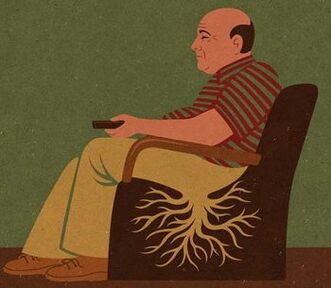
- Insufficient column support in careless movements, which leads to overloading intervertebral discs, displacement of vertebrae and the appearance of intervertebral hernias.
- Deterioration of the blood supply to the spine: the dynamic work of the skeletal muscles is a previous requirement for the blood flow to any organ, including the spine.As a result of the insufficient functioning of the back muscles, the progress of intervertebral discs in progress: cells die from a deficiency of nutrients and oxygen.And dead cells accumulate, interfering with restoration.
- Deterioration of lymphatic flow and venous exit, which leads to the accumulation of dead cells in the tissues.The work of the skeletal muscles is especially important for the work of the lymphatic system, since most of their vessels (for example, lymphocapillary) do not have muscle walls, and "push" the lymph in the blood vessels depends on the work of the skeletal muscles.
4 Principles of effective treatment
To eliminate not only the symptoms, but to deal with the cause of the development of osteochondrosis, spondylosis, radiculitis and ISHIAS, the following tasks must be resolved:
- Create opportunities to clean dead cell tissues.This is a necessary condition for recovery to prevent the additional formation of osteophytes and release the space for tissue regeneration.To do this, restore/strengthen the lymphatic flow and venous output of the affected segments;
- Improve blood supply to the affected area;
- Improve the tone of all the muscles that support the spine.This will allow:
- Create conditions for stimulationownblood flow and lymphatic flow in the column;
- Restore the operation of the neuromuscular depreciation system, which is necessary for adequate support for the spine, to avoid new damage.
- Eliminate pain, because this will give a chance:
- Remove the muscle clamps that block blood flow to the column;
- Avoid forced poses.
Medication therapy (medicinal)
Today, in the treatment of osteochondrosis and its complications, medications of the following groups are used:
- Necopoid anti -inflammatory drugs (NSAIDs)- In the form of drugs or drug injections.These funds have the ability to reduce pain, reduce inflammation activity.However, the effect of its use does not last long, from several hours to two to three days.Therefore, such funds must be taken for a long time, weeks and sometimes months.At the same time, these drugs negatively affect the mucous membranes of the gastrointestinal tract.Its long -term reception is loaded with the development of gastritis, ulcer lesions.In addition, they can negatively affect the work of the kidneys, the liver and contribute to the development of hypertension.And, at the same time, these funds do not contribute to the cleaning of dead cell discs.Therefore, its use is only a way to relieve symptoms for a while, but not eliminate the main problem.
- CTEPOID (goopmonal) anti -inflammatory.As a general rule, they are used for severe and impenetrable pains that accompany hernia, radiculitis, ishias, etc.Gopmons have the ability to eliminate inflammation manifestations (due to the oppression of the immune system), relieve pain.But they also negatively affect the mucous membranes of the stomach and the intestine, promote the leaching of the calcium of the bones, inhibit the production of their own Gopmons.And do not contribute to clean the focus of dead cells.
- Papamolic- Drugs that affect the muscles or nerves that go to the muscles and cause relaxation of the skeletal muscles.These media help relieve muscle clamps for a while, reduce pain and improve blood flow.But at the same time, they do not help clean the tissue of dead cells.Therefore, they do not contribute to the cure for osteochondrosis.
- Epiduvision block- The introduction of analgesics and gopmonal agents in the space between the solid brain cover and the periosteum that covers the vertebrae.It is used, as a rule, for intense pain: in the acute period of intervertebral hernia, with severe radiculitis, Ishias.Depending on the composition, this injection helps relieve pain for a period of several hours to several days.After the expiration date, manifestations of the disease are returned, because the procedure does not help restore metabolic processes on the discs.In addition, when it is carried out, there is a risk of lesions in blood vessels and nerves.
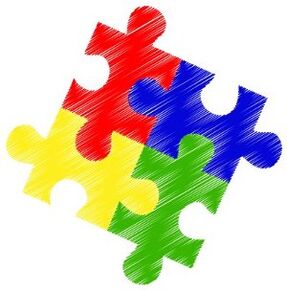
As osteochondrosis and the development of complications advanceYou have to resort to medications more and more often, increase the doses.This leads to high financial costs, as well as a greater deterioration of health due to the side effects of medicines.
Pharmacological therapy, as a rule, is complemented by the immobilization of one or friend of the column using orthopedic corsets of various degrees of rigidity.
























